TOYOTA 86 2022 Service Manual
Manufacturer: TOYOTA, Model Year: 2022, Model line: 86, Model: TOYOTA 86 2022Pages: 449, PDF Size: 8.5 MB
Page 41 of 449
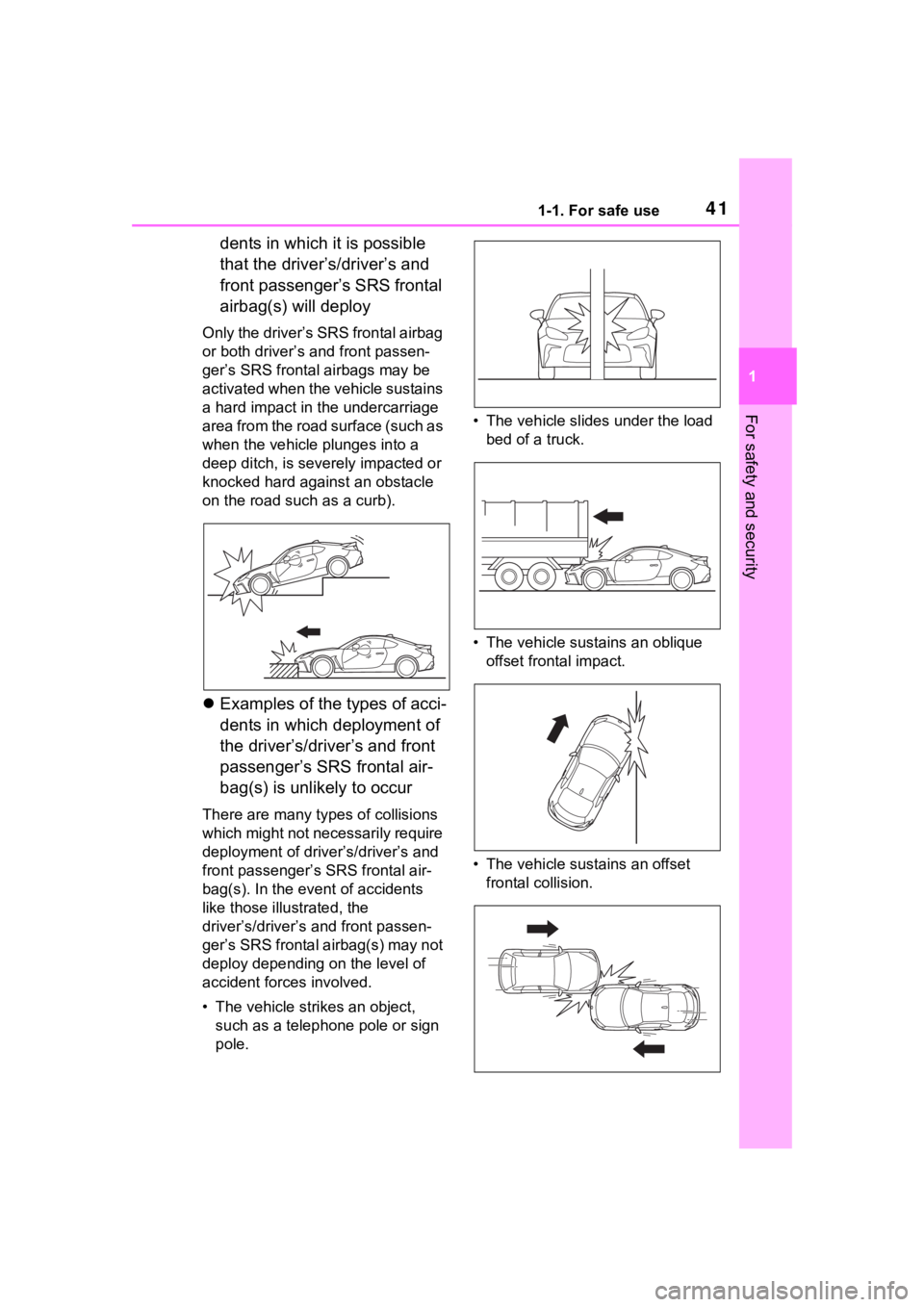
411-1. For safe use
1
For safety and security
dents in which it is possible
that the driver’s/driver’s and
front passenger’s SRS frontal
airbag(s) will deploy
Only the driver’s SRS frontal airbag
or both driver’s and front passen-
ger’s SRS frontal airbags may be
activated when the vehicle sustains
a hard impact in the undercarriage
area from the road surface (such as
when the vehicle plunges into a
deep ditch, is seve rely impacted or
knocked hard against an obstacle
on the road such as a curb).
Examples of the types of acci-
dents in which deployment of
the driver’s/driver’s and front
passenger’s SRS frontal air-
bag(s) is unlikely to occur
There are many types of collisions
which might not necessarily require
deployment of driver’s/driver’s and
front passenger’s SRS frontal air-
bag(s). In the eve nt of accidents
like those illu strated, the
driver’s/driver’s and front passen-
ger’s SRS frontal airbag(s) may not
deploy depending on the level of
accident forces involved.
• The vehicle strikes an object, such as a telephone pole or sign
pole. • The vehicle slides under the load
bed of a truck.
• The vehicle sustains an oblique offset frontal impact.
• The vehicle sustains an offset frontal collision.
Page 42 of 449
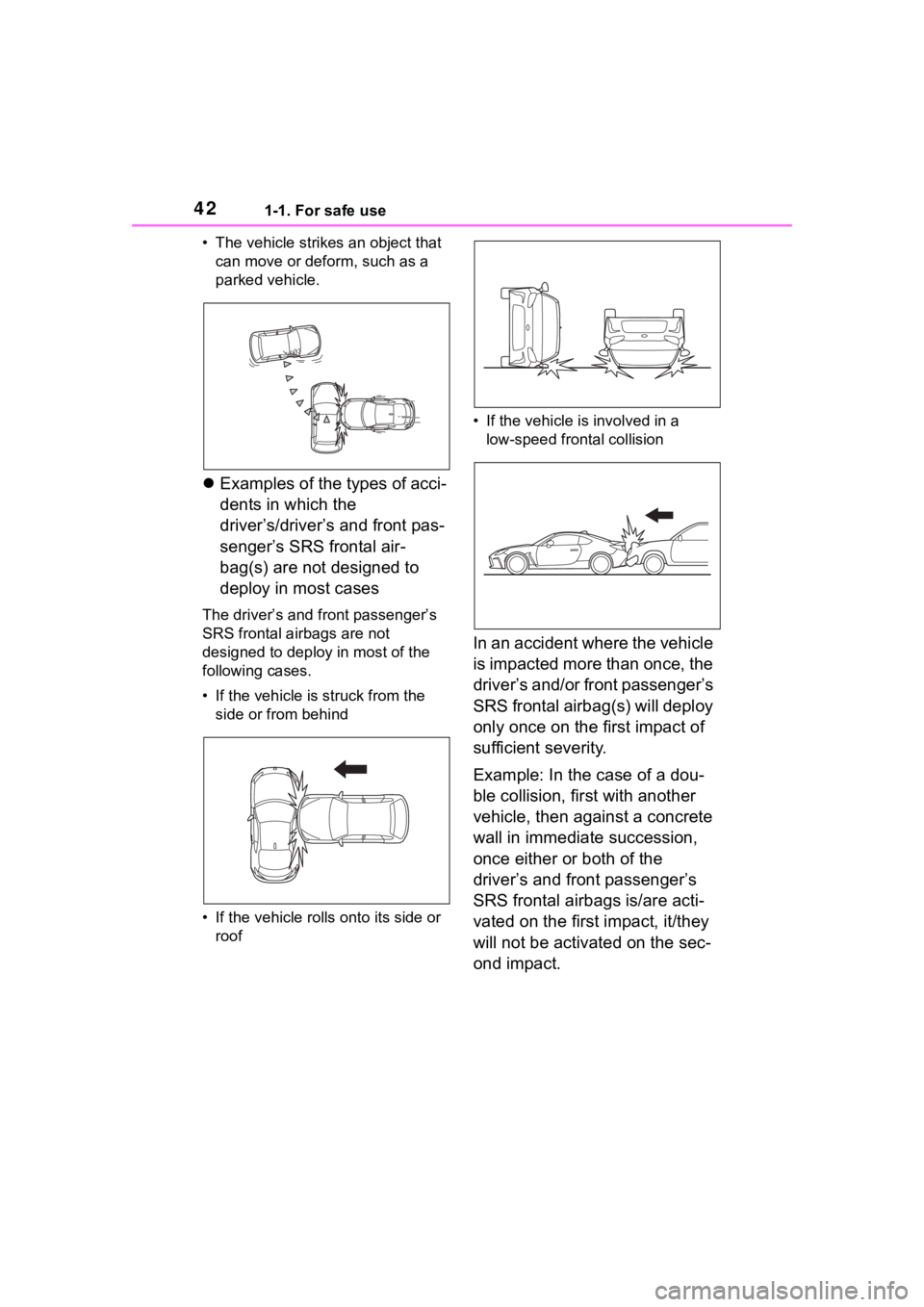
421-1. For safe use
• The vehicle strikes an object that can move or deform, such as a
parked vehicle.
Examples of the types of acci-
dents in which the
driver’s/driver’s and front pas-
senger’s SRS frontal air-
bag(s) are not designed to
deploy in most cases
The driver’s and front passenger’s
SRS frontal ai rbags are not
designed to deploy in most of the
following cases.
• If the vehicle is struck from the side or from behind
• If the vehicle rolls onto its side or
roof • If the vehicle is involved in a
low-speed fron tal collision
In an accident where the vehicle
is impacted more than once, the
driver’s and/or front passenger’s
SRS frontal airbag(s) will deploy
only once on the first impact of
sufficient severity.
Example: In the case of a dou-
ble collision, first with another
vehicle, then against a concrete
wall in immediate succession,
once either or both of the
driver’s and front passenger’s
SRS frontal airbags is/are acti-
vated on the first impact, it/they
will not be activated on the sec-
ond impact.
Page 43 of 449
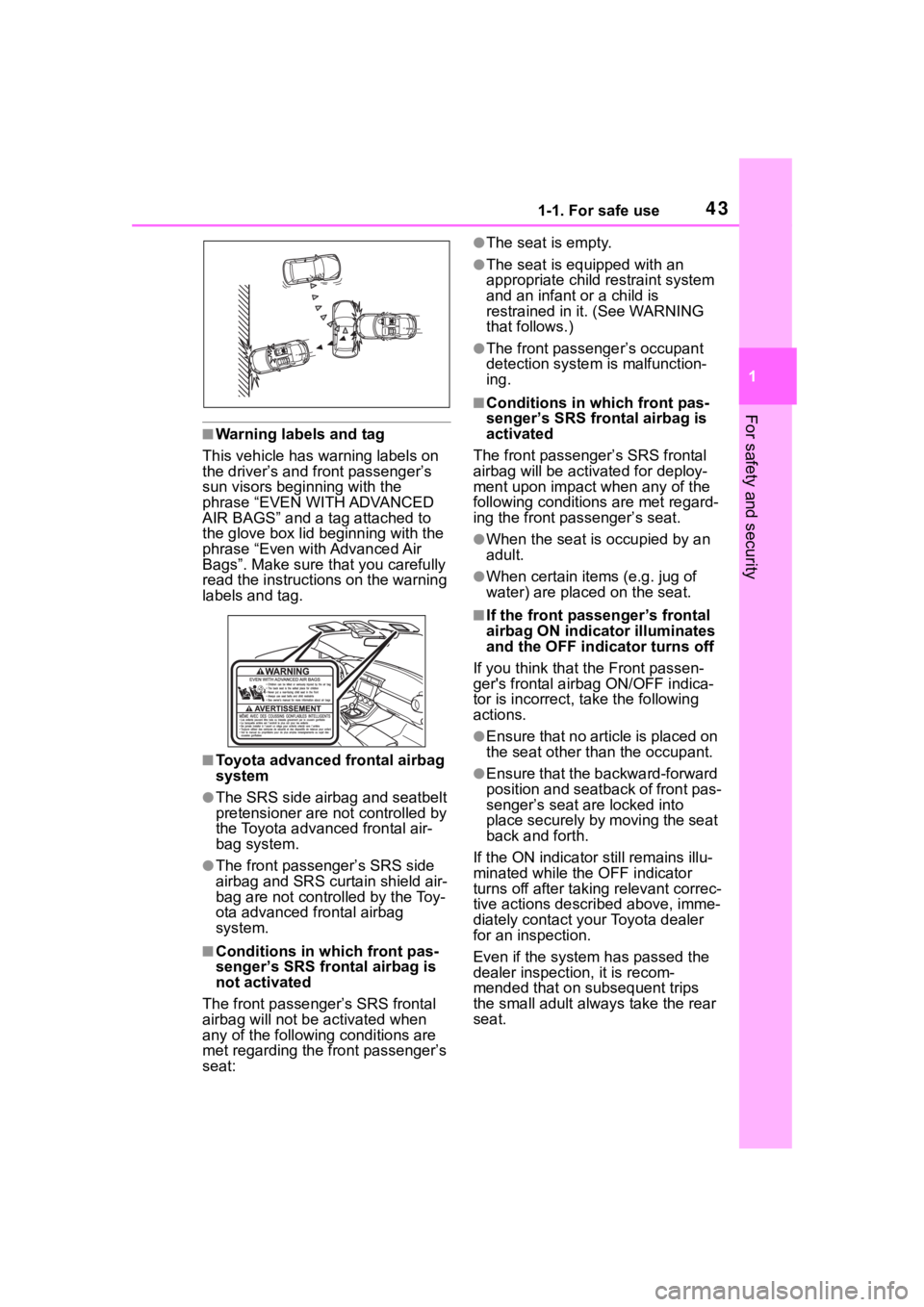
431-1. For safe use
1
For safety and security
■Warning labels and tag
This vehicle has warning labels on
the driver’s and front passenger’s
sun visors beginning with the
phrase “EVEN WITH ADVANCED
AIR BAGS” and a tag attached to
the glove box lid beginning with the
phrase “Even with Advanced Air
Bags”. Make sure that you carefully
read the instructions on the warning
labels and tag.
■Toyota advanced frontal airbag
system
●The SRS side airbag and seatbelt
pretensioner are not controlled by
the Toyota advanced frontal air-
bag system.
●The front passenger’s SRS side
airbag and SRS curtain shield air-
bag are not controlled by the Toy-
ota advanced frontal airbag
system.
■Conditions in which front pas-
senger’s SRS frontal airbag is
not activated
The front passenger’s SRS frontal
airbag will not be activated when
any of the following conditions are
met regarding the front passenger’s
seat:
●The seat is empty.
●The seat is equipped with an
appropriate child restraint system
and an infant or a child is
restrained in i t. (See WARNING
that follows.)
●The front passenger’s occupant
detection system is malfunction-
ing.
■Conditions in which front pas-
senger’s SRS frontal airbag is
activated
The front passenge r’s SRS frontal
airbag will be activ ated for deploy-
ment upon impact when any of the
following conditions are met regard-
ing the front passenger’s seat.
●When the seat is occupied by an
adult.
●When certain items (e.g. jug of
water) are plac ed on the seat.
■If the front passenger’s frontal
airbag ON indicator illuminates
and the OFF indicator turns off
If you think that the Front passen-
ger's frontal airb ag ON/OFF indica-
tor is incorrect, take the following
actions.
●Ensure that no article is placed on
the seat other than the occupant.
●Ensure that the backward-forward
position and seatback of front pas-
senger’s seat are locked into
place securely by moving the seat
back and forth.
If the ON indicator still remains illu-
minated while the OFF indicator
turns off after taking relevant correc-
tive actions descr ibed above, imme-
diately contact your Toyota dealer
for an inspection.
Even if the system has passed the
dealer inspection, it is recom-
mended that on subsequent trips
the small adult alwa ys take the rear
seat.
Page 44 of 449

441-1. For safe use
■If the passenger’s frontal airbag
OFF indicator illuminates and
the ON indicator turns off even
when the front passenger’s seat
is occupied by an adult
This can be caused by the adult
incorrectly sittin g in the front pas-
senger’s seat.
1 Turn the engine switch off.
2 Ask the front passenger to set
the seatback to the upright posi-
tion, sit up straight in the center
of the seat cushion, correctly fas-
ten the seatbelt, position his/her
legs out forward, and adjust the
seat to the rearmost position.
3 Turn the engine switch to ON.
If the OFF indicat or remains illumi-
nated while the ON indicator
remains off, take the following
actions.
1 Turn the engine switch off.
2 Make sure that the front passen-
ger does not use a blanket, extra
seat cushion, sea t cover, extra
seat heater or massager, etc.
3 If wearing excess ive layers of
clothing, the front passenger
should remove any unnecessary
items before sitting in the front
passenger’s seat, or should sit in
a rear seat.
4 Turn the engine switch to ON
and wait 6 seconds to allow the
system to complete self-check-
ing. Following the system check,
both indicators turn off for 2 sec-
onds. Now, the ON indicator
should illuminate while the OFF
indicator remains off.
If the OFF indicator still remains illu-
minated while the ON indicator
remains off, ask the occupant to
move to the rear seat and immedi-
ately contact your Toyota dealer for
an inspection.■If the seatbelt buckle switch
and/or front passenger’s occu-
pant detection system have
failed
If the seatbelt buckle switch and/or
front passenger’s occupant detec-
tion system have failed, the SRS
warning light will illuminate. Have
the system inspected by your Toyota
dealer immediately if the SRS warn-
ing light illuminates.
■If the front passenger’s seat
cushion is wet
If the front passenger’s seat cushion
is wet, this may adversely affect the
ability of the syst em to determine
deployment. Wipe off liquid from the
seat, let the seat dry naturally and
then check the SRS warning light.
If the front passeng er’s frontal air-
bag ON and OFF indicators do not
work properly even when the front
passenger’s seat is dry, do not allow
anyone to sit on the front passen-
ger’s seat and hav e the occupant
detection system checked by your
Toyota dealer.
Also, if luggage or electronic
devices are placed on the front pas-
senger’s seat, this may adversely
affect the ability of the system to
determine deployment. This may
prevent the front passenger’s frontal
airbag ON and OFF indicators from
working properly. Check that the
indicators work properly.
When the OFF indicator turns off
and the ON indicato r illuminates, the
front passenger’s frontal airbag may
deploy during a collision. Remove
luggage and electronic devices from
the front passenger’s seat.
■When to contact your Toyota
dealer
If your vehicle has sustained impact,
this may affect the proper function of
the Toyota advanced frontal airbag
system. Have your vehicle
inspected at your Toyota dealer. Do
not use the front passenger’s seat
while driving the vehicle to your Toy-
Page 45 of 449
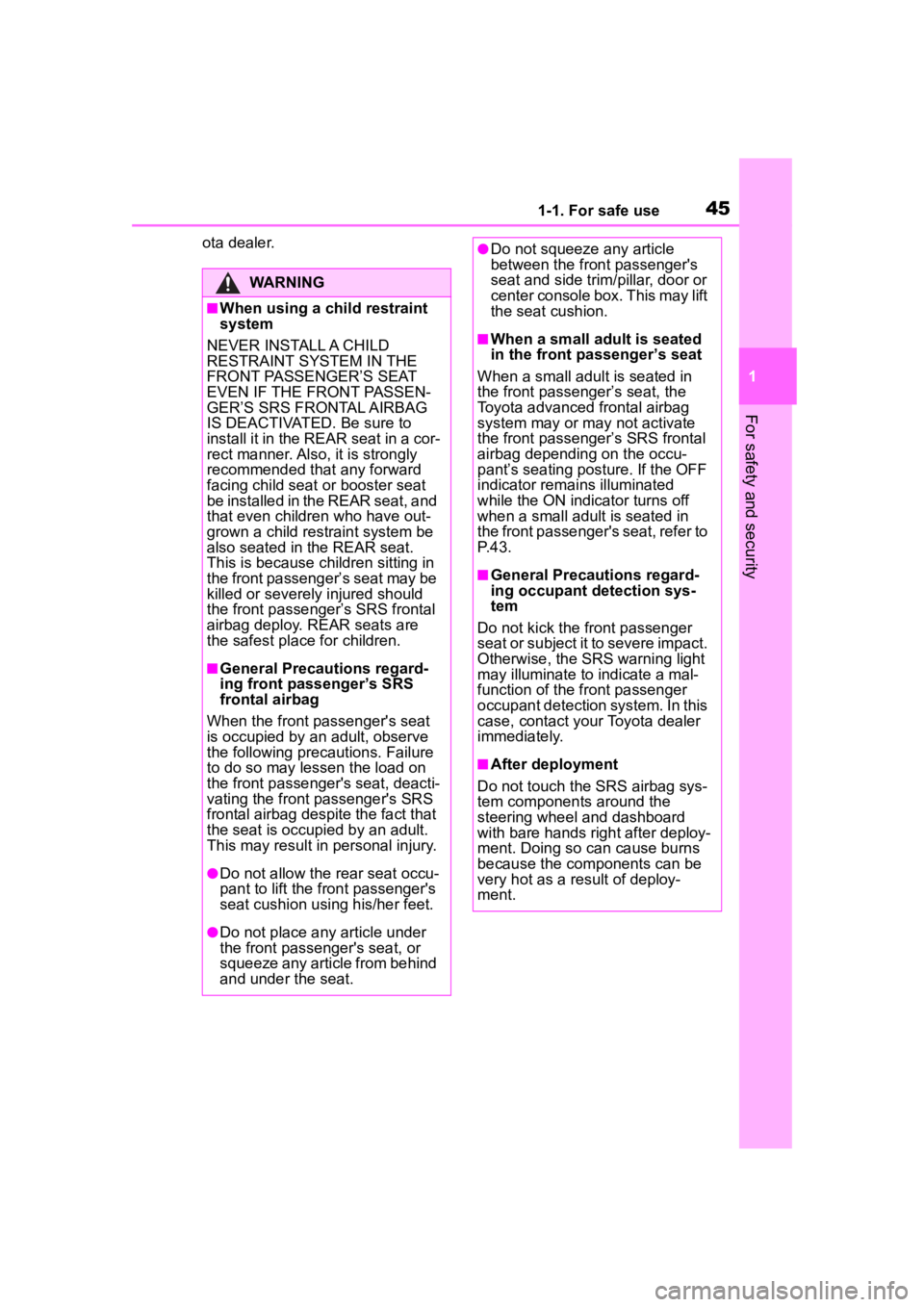
451-1. For safe use
1
For safety and security
ota dealer.
WARNING
■When using a child restraint
system
NEVER INSTALL A CHILD
RESTRAINT SYSTEM IN THE
FRONT PASSENGER’S SEAT
EVEN IF THE FRONT PASSEN-
GER’S SRS FRONTAL AIRBAG
IS DEACTIVATED. Be sure to
install it in the REAR seat in a cor-
rect manner. Also, it is strongly
recommended that any forward
facing child seat o r booster seat
be installed in the REAR seat, and
that even children who have out-
grown a child restraint system be
also seated in the REAR seat.
This is because children sitting in
the front passenger’s seat may be
killed or severely injured should
the front passenger’s SRS frontal
airbag deploy. REAR seats are
the safest place for children.
■General Precautions regard-
ing front passenger’s SRS
frontal airbag
When the front passenger's seat
is occupied by an adult, observe
the following precautions. Failure
to do so may lessen the load on
the front passenger 's seat, deacti-
vating the front passenger's SRS
frontal airbag despite the fact that
the seat is occupied by an adult.
This may result in personal injury.
●Do not allow the rear seat occu-
pant to lift the front passenger's
seat cushion using his/her feet.
●Do not place any article under
the front passenger's seat, or
squeeze any article from behind
and under the seat.
●Do not squeeze any article
between the front passenger's
seat and side trim /pillar, door or
center console box. This may lift
the seat cushion.
■When a small adu lt is seated
in the front passenger’s seat
When a small adult is seated in
the front passenger’s seat, the
Toyota advanced frontal airbag
system may or may not activate
the front passenger’s SRS frontal
airbag depending on the occu-
pant’s seating posture. If the OFF
indicator rema ins illuminated
while the ON indicator turns off
when a small adult is seated in
the front passenger's seat, refer to
P.43.
■General Precautions regard-
ing occupant detection sys-
tem
Do not kick the front passenger
seat or subject it to severe impact.
Otherwise, the SRS warning light
may illuminate to indicate a mal-
function of the front passenger
occupant detection system. In this
case, contact your Toyota dealer
immediately.
■After deployment
Do not touch the SRS airbag sys-
tem components around the
steering wheel and dashboard
with bare hands right after deploy-
ment. Doing so can cause burns
because the components can be
very hot as a result of deploy-
ment.
Page 46 of 449
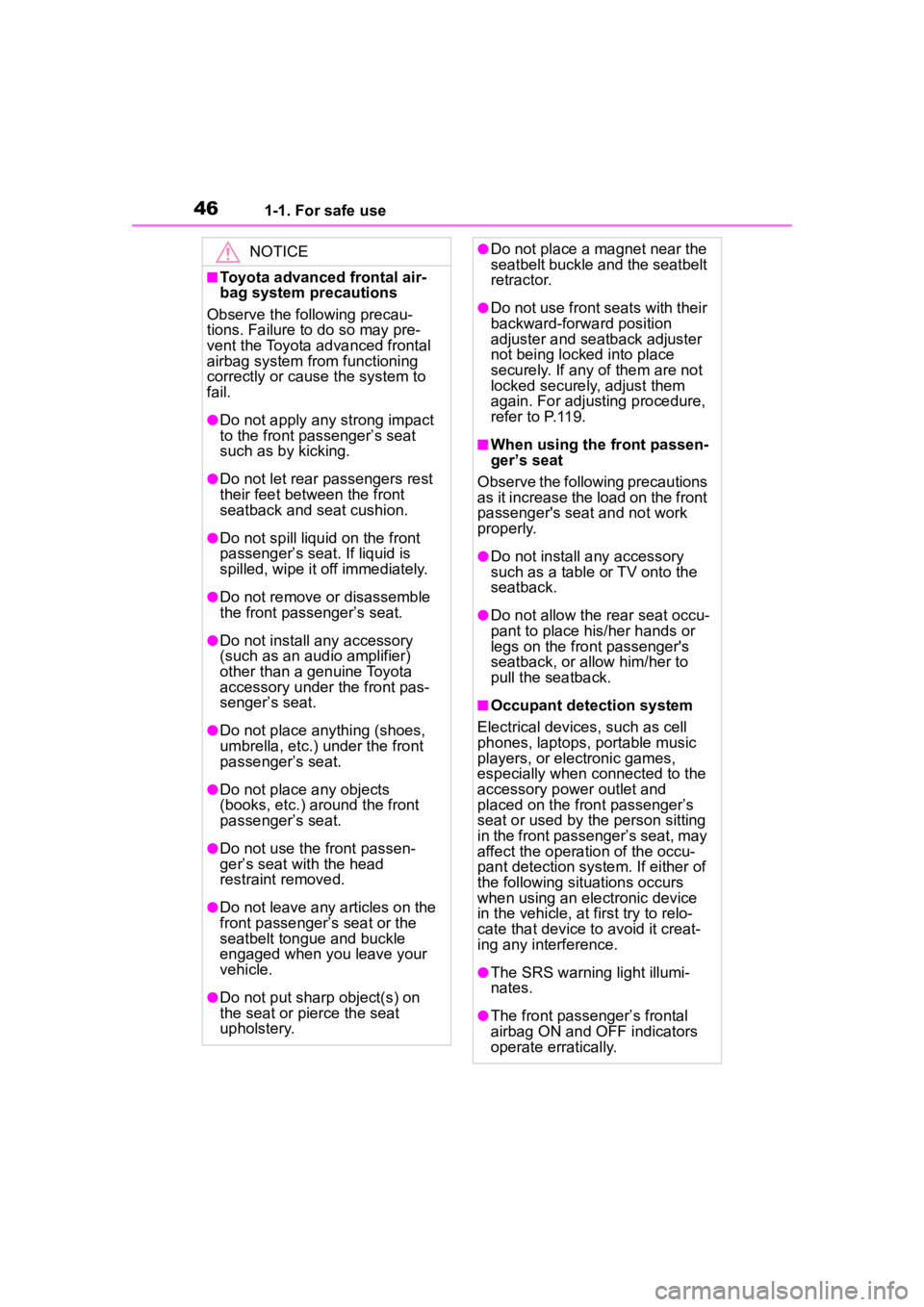
461-1. For safe use
NOTICE
■Toyota advanced frontal air-
bag system precautions
Observe the following precau-
tions. Failure to do so may pre-
vent the Toyota advanced frontal
airbag system from functioning
correctly or cause the system to
fail.
●Do not apply any strong impact
to the front passenger’s seat
such as by kicking.
●Do not let rear passengers rest
their feet bet ween the front
seatback and seat cushion.
●Do not spill liqui d on the front
passenger’s seat. If liquid is
spilled, wipe it off immediately.
●Do not remove or disassemble
the front passenger’s seat.
●Do not install any accessory
(such as an audio amplifier)
other than a genuine Toyota
accessory under the front pas-
senger’s seat.
●Do not place anything (shoes,
umbrella, etc.) under the front
passenger’s seat.
●Do not place any objects
(books, etc.) around the front
passenger’s seat.
●Do not use the front passen-
ger’s seat with the head
restraint removed.
●Do not leave any articles on the
front passenger’ s seat or the
seatbelt tongue and buckle
engaged when you leave your
vehicle.
●Do not put sharp object(s) on
the seat or pierce the seat
upholstery.
●Do not place a magnet near the
seatbelt buckle and the seatbelt
retractor.
●Do not use front seats with their
backward-forwa rd position
adjuster and seatback adjuster
not being locked into place
securely. If any of them are not
locked securely, adjust them
again. For adjusting procedure,
refer to P.119.
■When using the front passen-
ger’s seat
Observe the following precautions
as it increase the load on the front
passenger's seat and not work
properly.
●Do not install any accessory
such as a table or TV onto the
seatback.
●Do not allow the rear seat occu-
pant to place his/her hands or
legs on the front passenger's
seatback, or allow him/her to
pull the seatback.
■Occupant detection system
Electrical devices, such as cell
phones, laptops, portable music
players, or electronic games,
especially when connected to the
accessory power outlet and
placed on the front passenger’s
seat or used by the person sitting
in the front passenger’s seat, may
affect the operation of the occu-
pant detection system. If either of
the following situ ations occurs
when using an electronic device
in the vehicle, at first try to relo-
cate that device to avoid it creat-
ing any interference.
●The SRS warning light illumi-
nates.
●The front passenger’s frontal
airbag ON and OFF indicators
operate erratically.
Page 47 of 449
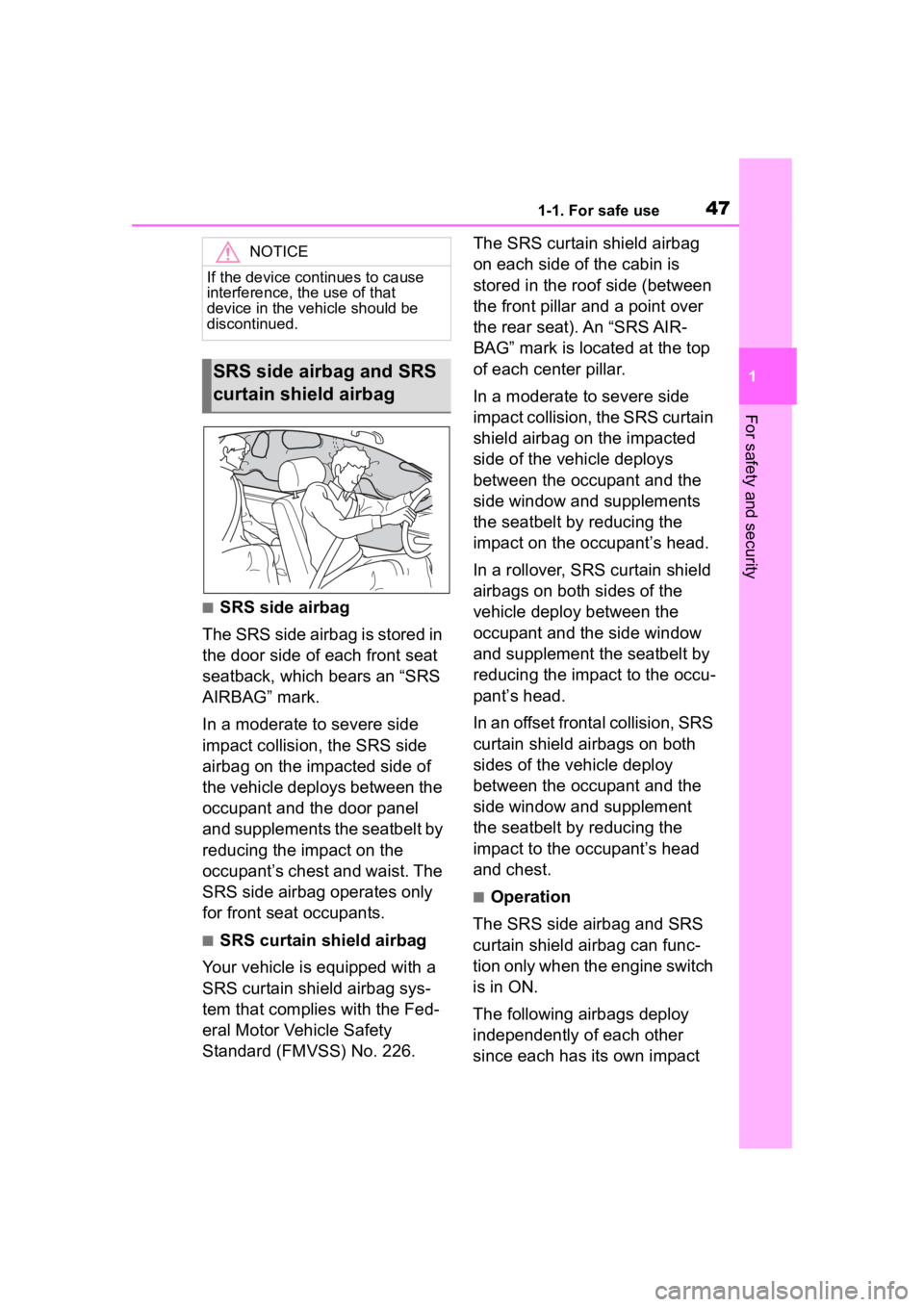
471-1. For safe use
1
For safety and security
■SRS side airbag
The SRS side airbag is stored in
the door side of each front seat
seatback, which bears an “SRS
AIRBAG” mark.
In a moderate to severe side
impact collision, the SRS side
airbag on the impacted side of
the vehicle deploys between the
occupant and the door panel
and supplements the seatbelt by
reducing the impact on the
occupant’s chest and waist. The
SRS side airbag operates only
for front seat occupants.
■SRS curtain shield airbag
Your vehicle is equipped with a
SRS curtain shield airbag sys-
tem that complies with the Fed-
eral Motor Vehicle Safety
Standard (FMVSS) No. 226. The SRS curtain shield airbag
on each side of the cabin is
stored in the roof side (between
the front pillar and a point over
the rear seat). An “SRS AIR-
BAG” mark is located at the top
of each center pillar.
In a moderate to severe side
impact collision, the SRS curtain
shield airbag on the impacted
side of the vehicle deploys
between the occupant and the
side window and supplements
the seatbelt by reducing the
impact on the occupant’s head.
In a rollover, SRS curtain shield
airbags on both sides of the
vehicle deploy between the
occupant and the side window
and supplement the seatbelt by
reducing the impact to the occu-
pant’s head.
In an offset frontal collision, SRS
curtain shield airbags on both
sides of the vehicle deploy
between the occupant and the
side window and supplement
the seatbelt by reducing the
impact to the occupant’s head
and chest.
■Operation
The SRS side airbag and SRS
curtain shield airbag can func-
tion only when the engine switch
is in ON.
The following airbags deploy
independently of each other
since each has its own impact
NOTICE
If the device continues to cause
interference, the use of that
device in the vehicle should be
discontinued.
SRS side airbag and SRS
curtain shield airbag
Page 48 of 449

481-1. For safe use
sensor.
Driver’s SRS side airbag
Front passenger’s SRS side
airbag
SRS curtain shield airbag
(right-hand side)
SRS curtain shield airbag
(left-hand side)
Therefore, they may not both
deploy in the same accident.
Also, the SRS side airbag and
SRS curtain shield airbag
deploys independently of the
driver’s and front passenger’s
SRS frontal airbags in the steer-
ing wheel and instrument panel.
For the locations of the sensors
and control modules, refer to
P.27.
■After deployment
After the deployment, the SRS
side airbag immediately starts to
deflate. The time required from
detection of an impact to defla-
tion of an SRS side airbag after
deployment is shorter than the
blink of an eye.
The SRS curtain shield airbag
remains inflated for a while fol-
lowing deployment then slowly
deflates.
The SRS side airbag and SRS
curtain shield airbag deploy
even when no one occupies the
seat on the side on which an
impact is applied.
When the SRS side airbag and SRS curtain shield airbag
deploy, a sudden, fairly loud
inflation noise will be heard and
some smoke will be released.
These occurrences are a normal
result of the deployment. This
smoke does not indicate a fire in
the vehicle.
■Example of the type of acci-
dent
The SRS side airbag and SRS
curtain shield airbag are
designed as follows:
To deploy in the event of an
accident involving a moderate
to severe side impact collision
To function on a one-time-only
basis.
The SRS side airbag and SRS
curtain shield airbag are not
designed to deploy in the follow-
ing cases:
In most lesser side impact
In most frontal or most rear
impacts (because the SRS
side airbag and SRS curtain
shield airbag deployment
would not protect the occu-
pant in those situations)
The SRS curtain shield airbags
are also designed to deploy
when the vehicle is in an
extremely inclined state such as
during a rollover. They are not
designed to deploy in most
lesser inclined states.
SRS side airbag and SRS cur-
Page 49 of 449
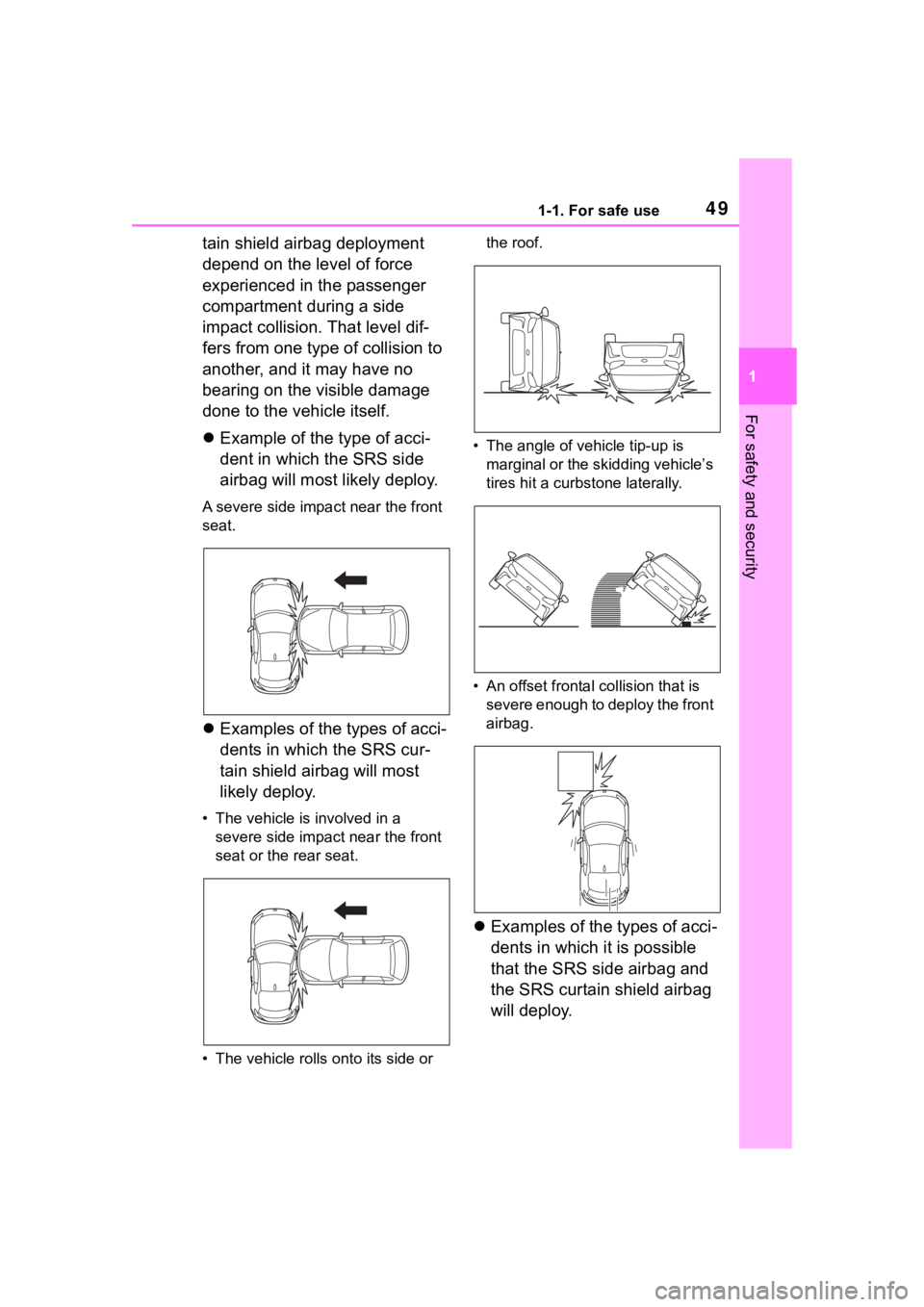
491-1. For safe use
1
For safety and security
tain shield airbag deployment
depend on the level of force
experienced in the passenger
compartment during a side
impact collision. That level dif-
fers from one type of collision to
another, and it may have no
bearing on the visible damage
done to the vehicle itself.
Example of the type of acci-
dent in which the SRS side
airbag will most likely deploy.
A severe side impa ct near the front
seat.
Examples of the types of acci-
dents in which the SRS cur-
tain shield airbag will most
likely deploy.
• The vehicle is involved in a
severe side impac t near the front
seat or the rear seat.
• The vehicle rolls onto its side or the roof.
• The angle of vehicle tip-up is marginal or the skidding vehicle’s
tires hit a curbstone laterally.
• An offset frontal collision that is severe enough to deploy the front
airbag.
Examples of the types of acci-
dents in which it is possible
that the SRS side airbag and
the SRS curtain shield airbag
will deploy.
Page 50 of 449
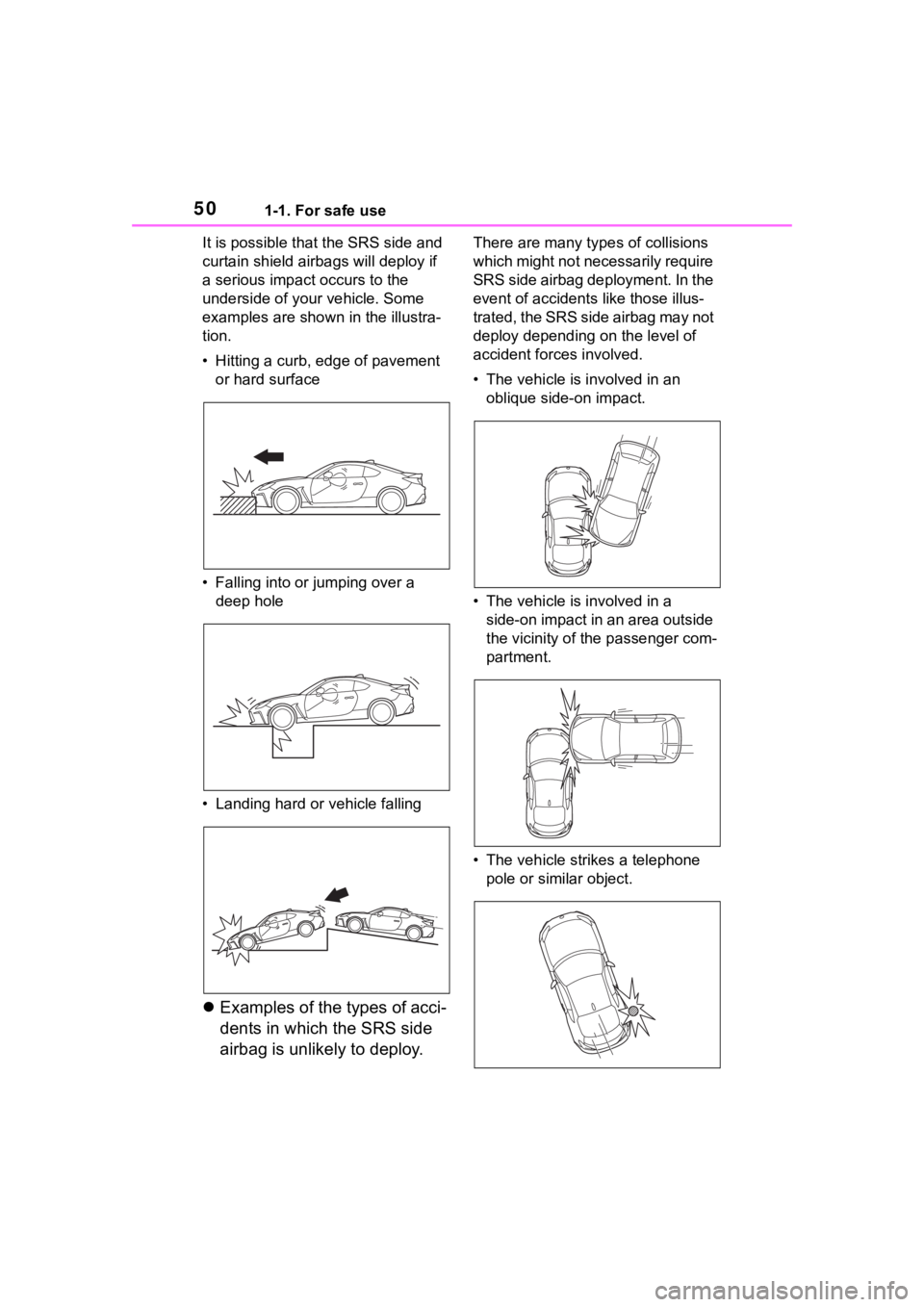
501-1. For safe use
It is possible that the SRS side and
curtain shield airbags will deploy if
a serious impact occurs to the
underside of your vehicle. Some
examples are shown in the illustra-
tion.
• Hitting a curb, edge of pavement or hard surface
• Falling into or jumping over a
deep hole
• Landing hard or vehicle falling
Examples of the types of acci-
dents in which the SRS side
airbag is unlikely to deploy.
There are many types of collisions
which might not necessarily require
SRS side airbag deployment. In the
event of accidents like those illus-
trated, the SRS side airbag may not
deploy depending on the level of
accident forces involved.
• The vehicle is involved in an
oblique side-on impact.
• The vehicle is involved in a side-on impact in an area outside
the vicinity of the passenger com-
partment.
• The vehicle strikes a telephone pole or similar object.